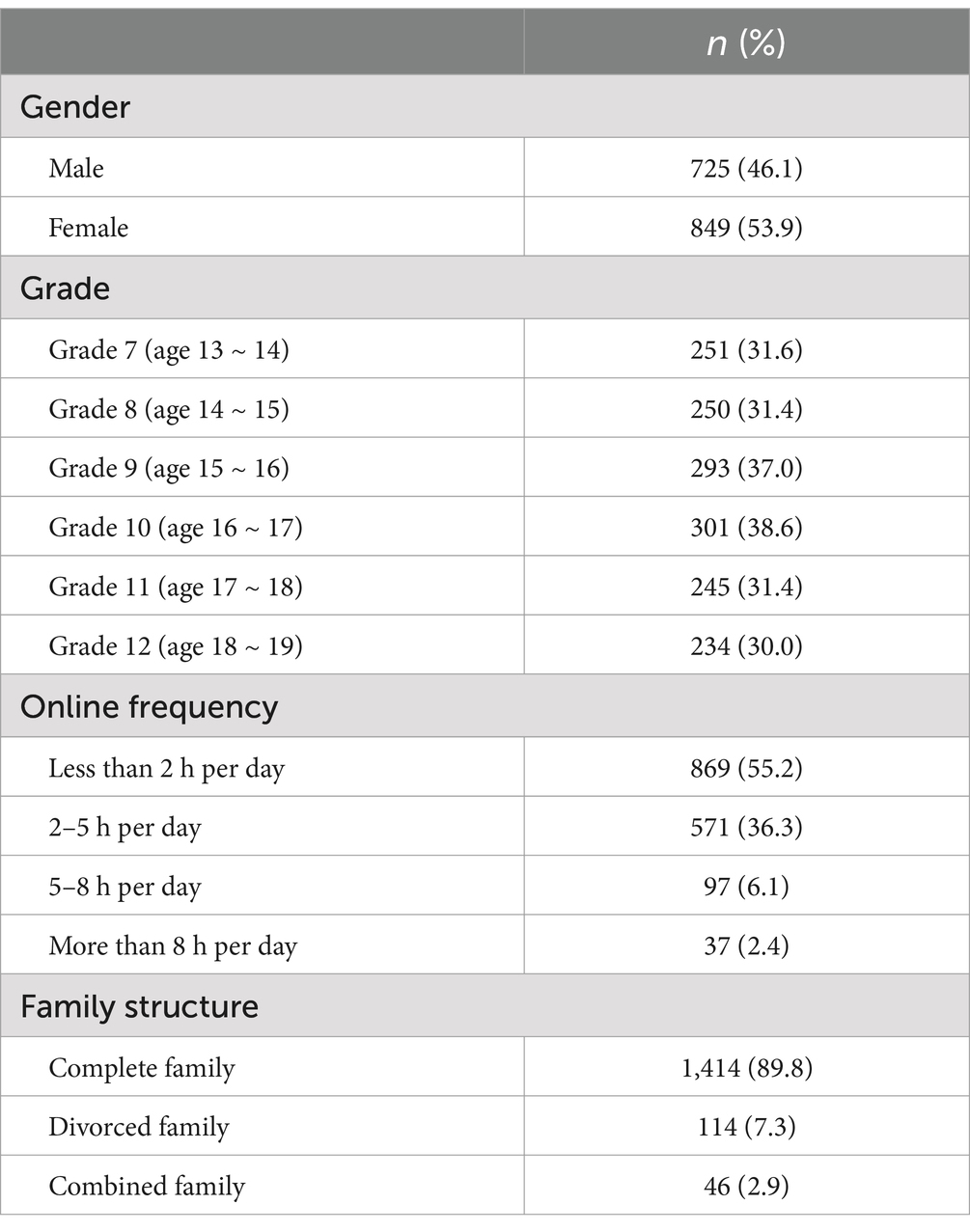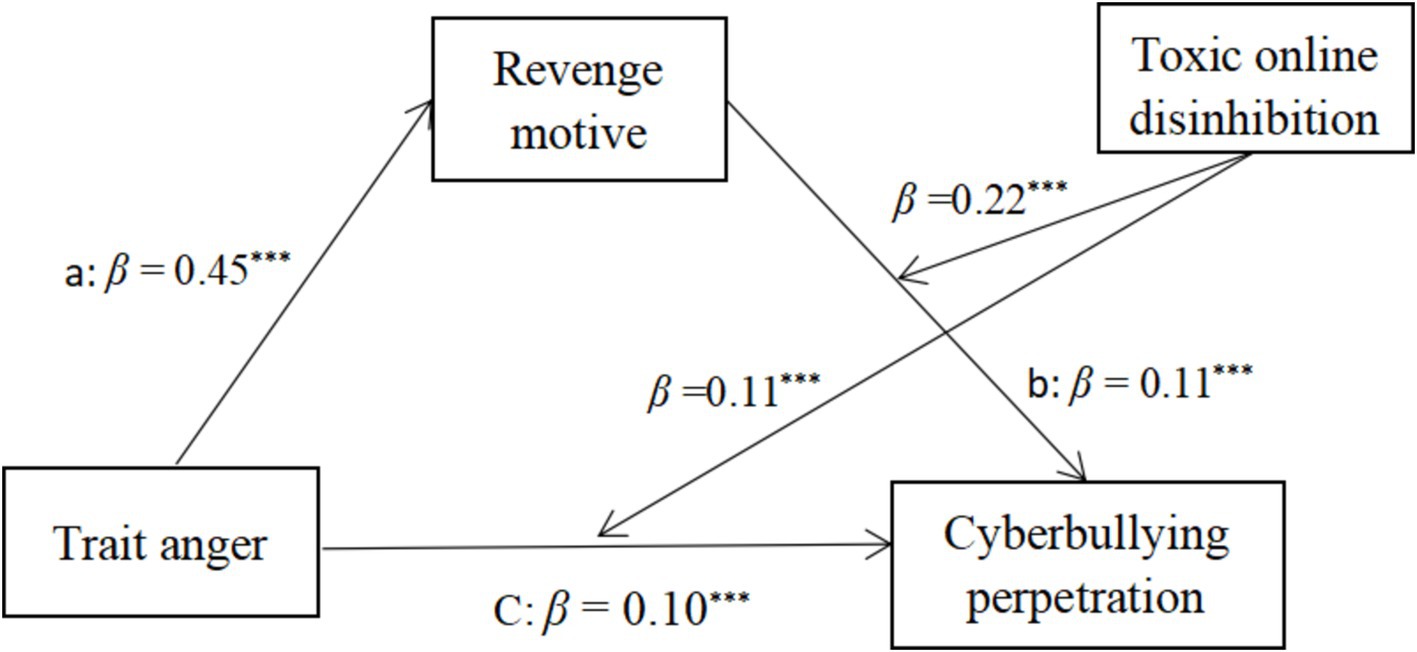- 1School of Humanities and Teacher Education, Wuyi University, Wuyishan, China
- 2Fuzhou University of International Studies and Trade, Fuzhou, China
- 3Chinese Academy of Education Big Data, Qufu Normal University, Qufu, China
Background: Trait anger has been identified as a significant risk factor in cyberbullying perpetration; however, the mechanisms underlying this relationship remain underexplored. This study aims to elucidate the connection between trait anger and cyberbullying perpetration among adolescents, with a focus on the mediating role of revenge motivation and the moderating effect of online disinhibition.
Methods: A sample of 1,574 Chinese adolescents (46.1% female, mean age 16.89 years, SD = 0.34) participated in the study. Participants completed measures assessing trait anger, revenge motivation, online disinhibition, and cyberbullying perpetration.
Results: Revenge motivation partially mediated the association between trait anger and cyberbullying perpetration. Furthermore, the relationship between revenge motivation and cyberbullying perpetration, as well as the relationship between trait anger and cyberbullying perpetration, were moderated by online disinhibition, with a significant association observed only among adolescents exhibiting higher levels of toxic disinhibition.
Conclusion: These findings extend the current understanding of cyberbullying perpetration among adolescents and offer valuable insights for intervention strategies targeting this antisocial online behavior.
1 Introduction
Cyberbullying perpetration, defined as intentional and harmful behavior performed by an individual or group using electronic devices, repeatedly and over time against a victim who cannot easily defend themselves (1), has emerged as a significant concern in the digital age. Research across cultures has documented the detrimental effects of cyberbullying on adolescents’ psychological well-being. While Western studies emphasize increased risks of substance use, anxiety, and depression (2, 3), research in China has identified additional culture-specific impacts, such as heightened academic pressure, family relationship strain, and unique manifestations of social withdrawal (4, 5). These cultural differences in both the expression and impact of cyberbullying highlight the importance of examining this phenomenon within specific cultural contexts.
A growing body of literature has identified trait anger (TA) as a predictive factor for cyberbullying perpetration [(e.g., 6–8)]. TA, defined as a tendency to experience irritation, annoyance, and rage (9), influences how individuals experience and express anger. Studies in China have revealed how collectivist cultural values shape the expression of trait anger in cyberbullying contexts (10–12), particularly given cultural emphases on emotional restraint and harmony maintenance (13).
In addition to trait anger, the online disinhibition effect presents unique characteristics in the Chinese digital landscape. While disinhibition refers to reduced behavioral restraint and concern for self-representation (14), its manifestation in Chinese digital spaces is shaped by distinct platform governance structures. Unlike Western platforms, Chinese social networking platforms operate under a real-name system that requires users to register with their actual information (15). This creates a unique environment for examining online disinhibition, which can be classified as either benign or toxic depending on the nature of the behavior (16). Studies in Chinese contexts suggest distinctive patterns of online disinhibition influenced by this real-name system and cultural norms (17).
Although previous research has examined individual characteristics, online disinhibition, and cyberbullying perpetration separately, limited research has considered their interrelationships within specific cultural contexts, especially in environments with mandatory real-name systems. To address these research gaps, the current study examines the link between trait anger and cyberbullying perpetration within the Chinese cultural context, investigating the mediating role of revenge motivation and the moderating role of online disinhibition among Chinese adolescents.
1.1 The mediating role of revenge motivation
Revenge motivation refers to the intention of a victim to inflict damage, injury, discomfort, or punishment on the party deemed responsible for causing harm (18). Although revenge is not the sole motivator for cyberbullying—including social status enhancement (19), entertainment (20), or perceived peer pressure (21)—it represents a significant pathway through which trait anger may lead to cyberbullying behaviors.
The General Aggression Model (GAM) (22) provides a theoretical framework for understanding how trait anger might lead to revenge motivation. The GAM suggests that personal factors (such as personality traits) and situational factors (like cues of aggression) influence internal states, including cognition, emotion, and arousal, which in turn affect appraisal and decision processes, ultimately leading to aggressive behavior. In this context, trait anger, as a stable personality characteristic predisposing individuals to experience frequent and intense anger across situations, may consistently influence how people process social information and respond to perceived provocations.
The connection between trait anger and revenge motivation can be understood through several mechanisms. First, trait anger influences cognitive processing: individuals high in trait anger tend to exhibit hostile attribution bias, leading them to consistently interpret ambiguous situations as threatening or provocative (23). This hostile interpretation style creates a cognitive foundation for revenge motivation. Second, trait anger affects emotional reactivity: high trait-angry individuals experience more frequent and intense angry emotions in response to provocations because their amygdala has weaker functional connectivity with the contralateral orbitofrontal cortex, and they have poorer ability to regulate their emotions (24), making them more likely to consider revenge as a viable response. Third, trait anger influences behavioral tendencies: those high in trait anger show lower thresholds for aggressive responses and are more likely to endorse revenge as a legitimate solution to perceived wrongs (25). These theoretical connections are supported by empirical evidence. For example, Wilkowski et al. (26) found that individuals with high trait anger showed stronger tendencies toward retaliatory responses when provoked. This finding aligns with the concept that trait anger creates a predisposition toward revenge-seeking behavior. Additionally, studies have demonstrated that high trait-angry individuals maintain angry thoughts longer (rumination) and are more likely to develop revenge plans in response to provocations (27, 28).
Importantly, revenge-motivated cyberbullying presents a unique dynamic in terms of power relationships. While traditional cyberbullying definitions emphasize power imbalance between perpetrator and target, revenge-based cyberbullying often involves what König et al. (29) termed “power redistribution,” where victims utilize digital technologies as equalizers to challenge traditional power dynamics. This aligns with the “revenge of the nerds” hypothesis (30), which suggests that technology can provide traditionally less powerful individuals with new means of retaliation. For instance, studies have shown that cyberbullying victims may use technological accessibility as coping mechanisms to counter perceived powerlessness (31, 32).
Research has identified revenge as both a reactive coping strategy and a primary motive for cyberbullying (33). Victims often view retaliation as a way to regain control or restore perceived justice. This pattern of retaliation can create cyclical behavior, where individuals with higher levels of trait anger are more prone to experiencing and acting on feelings of vengeance, potentially leading to escalating patterns of cyberbullying behavior (34). Therefore, while acknowledging that revenge is only one of several possible motivators, the current study hypothesizes that revenge motivation may serve as a significant mediator linking trait anger to cyberbullying perpetration (Hypothesis 1).
1.2 The moderating role of online disinhibition
The relationship between revenge motives and cyberbullying perpetration among adolescents is not uniform, and online disinhibition may play a crucial moderating role in this dynamic. Online disinhibition refers to a psychological state wherein individuals experience reduced constraints in cyberspace, leading to increased self-expression on digital platforms (35). For adolescents harboring revenge motives, the online environment may present a particularly tempting arena for engaging in cyberbullying behaviors, regardless of whether they choose to conceal their identity. The disinhibitory effects could lower impulse control, exacerbating the impact of revenge desires and behaviors that are often triggered during adolescence (36). This is particularly evident in the Chinese context, where despite mandatory real-name registration systems on social platforms, cyberbullying behaviors persist, demonstrating that factors beyond anonymity contribute to online disinhibition effects (37).
Online disinhibition can be categorized into two distinct types: toxic and benign (16). Toxic online disinhibition encompasses negative behaviors not typically observed offline, such as aggressive behaviors, harsh criticisms, and engagement in darker aspects of the Internet. Studies have found that higher levels of toxic disinhibition among students were associated with increased cyberbullying perpetration (38, 39). Conversely, benign disinhibition refers to behaviors that facilitate self-understanding, personal development, and conflict resolution (37). While no studies have explicitly examined benign disinhibition’s influence on cyberbullying perpetration, its promotion of enhanced self-reflection and perspective-taking may help individuals better regulate their emotional responses and consider the consequences of their actions.
In the Chinese context, investigating different types of online disinhibition is particularly important given the country’s distinct digital ecosystem. Despite reduced anonymity, online disinhibition effects may still occur through other mechanisms such as asynchronicity and perceived distance in online communications. This knowledge would be instrumental in developing targeted interventions that account for China’s specific digital context.
Based on previous research, we hypothesize that toxic online disinhibition may strengthen both the direct relationship between trait anger and cyberbullying perpetration, and the relationship between revenge motives and cyberbullying perpetration, while benign online disinhibition may weaken these relationships. These moderation effects can be explained through the Risk Enhancing Model and the Risk Buffer Model (40, 41). The Risk Enhancing Model suggests that toxic online disinhibition could amplify both the direct influence of trait anger and the influence of revenge motives on cyberbullying perpetration. Conversely, benign online disinhibition may serve as a protective factor by promoting emotional regulation and prosocial alternatives to aggression.
2 Present study
The current study examines the relationships between trait anger, revenge motivation, online disinhibition, and cyberbullying perpetration among Chinese adolescents through a moderated mediation model (see Figure 1). We propose three hypotheses:
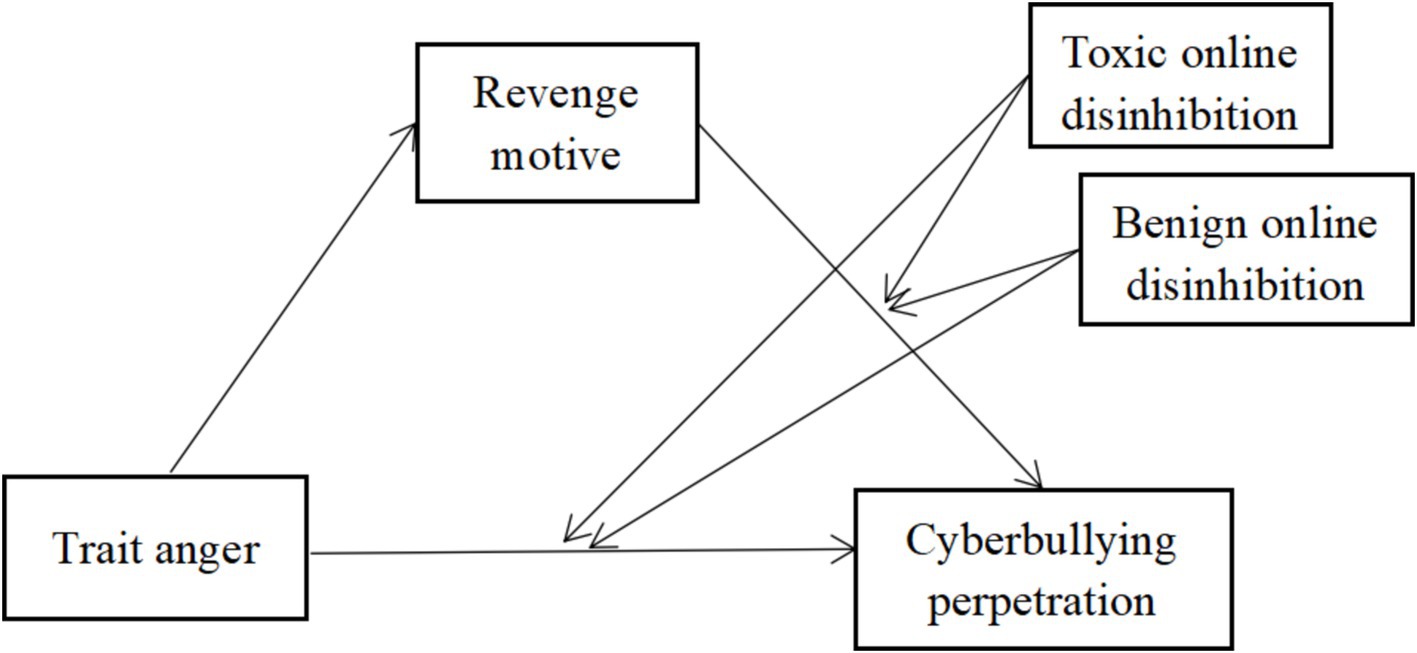
Figure 1. A moderated mediation model of trait anger, revenge motive, benign online disinhibition, toxic online disinhibition and cyberbullying perpetration.
Hypothesis 1: Revenge motivation mediates the relationship between trait anger and cyberbullying perpetration.
Hypothesis 2: The relationship between trait anger and cyberbullying perpetration is moderated by online disinhibition, with stronger effects under high toxic disinhibition and weaker effects under high benign disinhibition.
Hypothesis 3: The relationship between revenge motivation and cyberbullying perpetration is moderated by online disinhibition, following the same pattern as Hypothesis 2.
3 Method
3.1 Participants and procedure
The study sample consisted of 1,574 students (males = 849; females = 725) recruited through convenience sampling from seven junior and senior high schools in Fujian Province. Participants included 725 females (46.1%) and 794 junior high school students (50.4%), with a mean age of 16.89 years (SD = 0.34, range: 13–19 years).
The grade distribution included 251 (31.6%) 7th graders, 250 (31.4%) 8th graders, 293 (37.0%) 9th graders, 301 (38.6%) 10th graders, 245 (31.4%) 11th graders, and 234 (30.0%) 12th graders (see Table 1 for additional demographic information). Data collection was conducted using an online questionnaire system, Wenjuanxing,1 from October to December 2023. Inclusion criteria for the study were having experience using the internet and a willingness to participate in the study. The exclusion criteria were if more than half of the items were answered in a repetitive fashion or if questionnaires were nonconforming (completion time less than 100 s). Verbal consent was obtained from all participants and their guardians prior to providing them with an online survey link containing the consent form and scales. As an incentive, participants who completed the survey were entered into a draw for an online prize. The study protocol was approved by the Ethics Committee of the authors’ university.
3.2 Measures
3.2.1 Trait anger scale
Trait anger was assessed using the Chinese version of the Trait Anger Scale (42), adapted by Luo et al. (43). This 10-item scale employs a four-point response scale ranging from 1 (‘never’) to 4 (‘always’), with higher scores indicating higher levels of trait anger. A sample item is “When facing setbacks, I want to hit people.” The scale has demonstrated good validity and reliability among Chinese populations (43), with a Cronbach’s alpha of 0.89 and McDonald’s omega of 0.91 in the present study.
3.2.2 Revenge motive scale
Revenge motivation was measured using the revenge motivation subscale of the Transgression-Related Interpersonal Motivations Inventory (44). This subscale consists of five items rated on a five-point Likert scale ranging from 1 (“strongly disagree”) to 5 (“strongly agree”), with higher scores indicating greater revenge motivation. A sample item is “I hope they can receive the deserved retribution.” This scale has shown adequate reliability and validity in China (45), with a Cronbach’s alpha of 0.95 and McDonald’s omega of 0.92 in the current study.
3.2.3 Online disinhibition scale
The Online Disinhibition Scale (39) comprises 11 statements addressing two categories: benign online disinhibition (e.g., “I feel like a different person online”) and toxic online disinhibition (e.g., “Writing insulting things online is not bullying”). Participants rate their agreement on a 4-point Likert scale ranging from 1 (strongly disagree) to 4 (strongly agree), with higher scores indicating stronger online disinhibition. This scale has demonstrated adequate internal reliability and discriminant validity in Chinese populations (46). In this study, Cronbach’s alphas for the benign and toxic online disinhibition subscales were 0.88 and 0.83, respectively. The McDonald’s omega was 0.88 for both subscales.
3.2.4 Cyberbullying perpetration scale
Cyberbullying perpetration was measured using the cyberbullying subscale of the Chinese version of the Cyber Bullying Inventory (47), revised by Chu and Fan (48). This 14-item scale assesses the frequency of cyberbullying perpetration over the past 3 months through information and verbal aggression on various online platforms. Responses range on a scale from 1 (never) to 4 (three times). A sample item is “Post an indecent photo of someone online without permission.” Item scores were averaged, with higher scores indicating higher levels of cyberbullying perpetration. This scale has demonstrated good reliability and validity in Chinese populations (48), with a Cronbach’s alpha of 0.86 and McDonald’s omega of 0.89 in the present study.
3.3 Data analysis
To assess potential common method bias, we conducted Harman’s single-factor test (49). The analysis revealed that the first factor accounted for 24.46% of the total variance, which is below the 40% threshold suggested by Lee et al. (50), indicating that common method bias was not a significant concern in this study.
We began with descriptive statistics and calculated Spearman’s rank correlation coefficients (Spearman’s rho). This non-parametric correlation method was chosen because it does not assume normal distribution of the variables, making it particularly suitable for our potentially skewed data. To test the hypothesized moderated mediation model, we employed Hayes's (51) PROCESS macro for SPSS (Model 15) with 5,000 bootstrap samples and 95% bias-corrected confidence intervals. The bootstrapping approach was specifically selected because it does not require the assumption of normal distribution for indirect effects, making it robust for testing mediation effects in non-normally distributed data. This method enabled us to simultaneously examine both mediating and moderating effects within a single statistical model.
All analyses controlled for gender, grade level, family structure, and frequency of online use. These covariates were included based on previous research documenting their associations with trait anger, retaliatory behavior, and cyberbullying perpetration (8, 34, 52). By controlling for these variables, we aimed to isolate the unique effects of the primary variables of interest and enhance the robustness of the findings.
4 Results
4.1 Preliminary analysis
Descriptive statistics and correlations among study variables (trait anger, revenge motivation, benign online disinhibition, toxic online disinhibition, and cyberbullying perpetration) are presented in Table 2. Trait anger was positively correlated with revenge motivation, benign online disinhibition, toxic online disinhibition, and cyberbullying perpetration.
4.2 Testing for the proposed model
The results from PROCESS Model 15 are presented in Table 3. Mediation analyses revealed that trait anger significantly predicted cyberbullying perpetration (β = 0.10, SE = 0.02, t = 4.12, p < 0.001, R2 = 0.31, F = 76.52, p < 0.001; path c). Trait anger also positively predicted revenge motivation (β = 0.45, SE = 0.02, t = 19.48, p < 0.001, R2 = 0.22, F = 90.40, p < 0.001; path a), and revenge motivation positively predicted cyberbullying perpetration (β = 0.11, SE = 0.02, t = 4.48, p < 0.001; path b). The indirect effect through revenge motivation was significant (β = 0.05, SE = 0.01, p < 0.001, 95% CI [0.02, 0.08]). These results support Hypothesis 1, indicating that revenge motivation partially mediated the relationship between trait anger and cyberbullying perpetration.
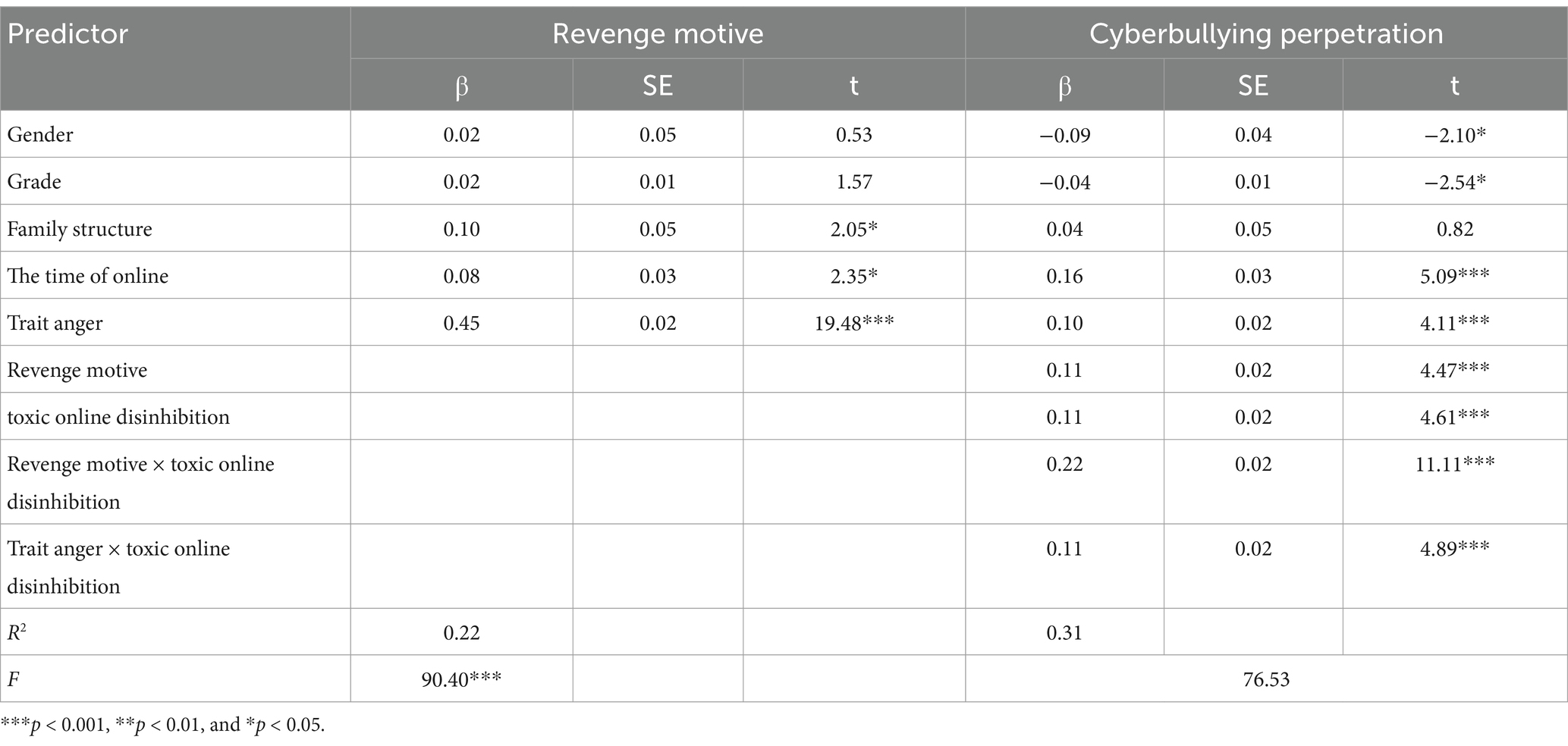
Table 3. Moderated mediation model testing the role of toxic online disinhibition in the relationship between trait anger and cyberbullying perpetration.
4.2.1 Effects of toxic online disinhibition as a moderator
Additionally, as shown in Table 3, toxic online disinhibition significantly moderated both the direct relationship between trait anger and cyberbullying perpetration (β = 0.11, p < 0.001) and the relationship between revenge motivation and cyberbullying perpetration (β = 0.22, p < 0.001). Figure 2 illustrates the moderated mediation pathways with standardized path coefficients.
To further examine the moderating role of toxic online disinhibition in the relationship between trait anger and cyberbullying perpetration, we conducted simple slope analyses. The relationship between trait anger and cyberbullying perpetration was plotted (Figure 3) for participants with low (1 SD below the mean) and high (1 SD above the mean) toxic online disinhibition. Simple slope analyses revealed that for individuals with low toxic online disinhibition, trait anger was not significantly associated with cyberbullying perpetration (β = −0.02, SE = 0.02, t = −0.67, p = 0.51). However, for individuals with high toxic online disinhibition, there was a significant positive association between trait anger and cyberbullying perpetration (β = 0.32, SE = 0.03, t = 11.03, p < 0.001).
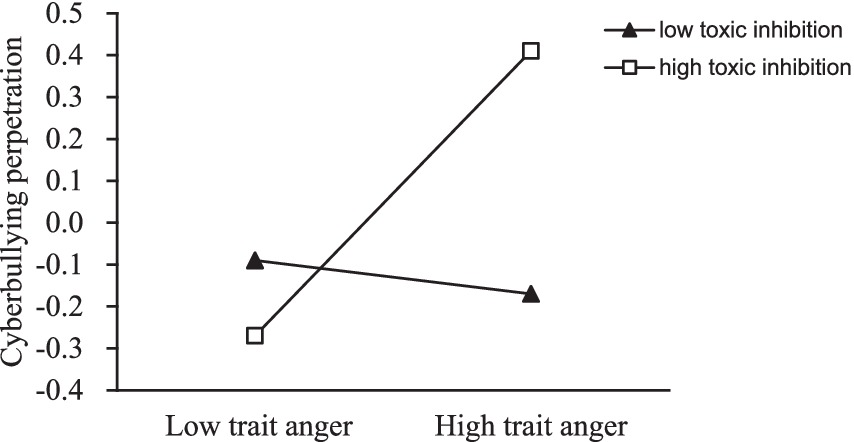
Figure 3. The relationship between trait anger and cyberbullying perpetration at two levels of toxic online disinhibition: (1) low toxic online disinhibition (1SD below the mean) and (2) high toxic online disinhibition (1SD above the mean).
Similarly, we examined the moderating role of toxic online disinhibition in the relationship between revenge motivation and cyberbullying perpetration. The relationship was plotted (Figure 4) for participants with low and high toxic online disinhibition (±1 SD from the mean). Simple slope analyses indicated that for individuals with low toxic online disinhibition, the association between revenge motivation and cyberbullying perpetration was not significant (β = 0.05, SE = 0.03, t = 1.76, p = 0.07). In contrast, for those with high toxic online disinhibition, revenge motivation was positively associated with cyberbullying perpetration (β = 0.21, SE = 0.03, t = 6.87, p < 0.001).
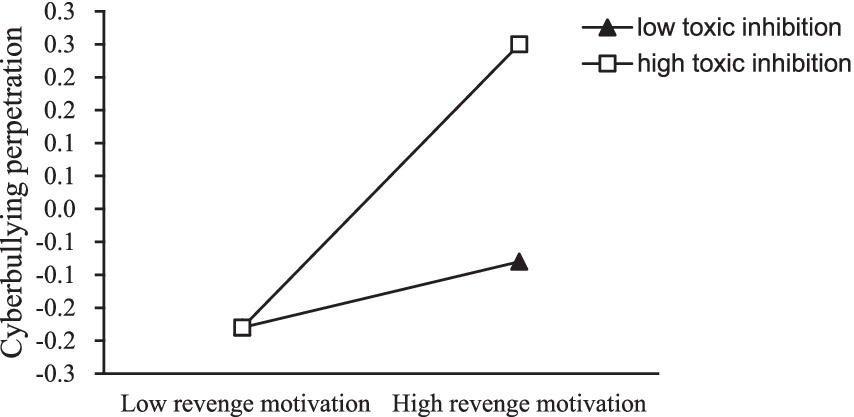
Figure 4. The relationship between revenge motive and cyberbullying perpetration at two levels of toxic online disinhibition: (1) low toxic online disinhibition (1SD below the mean) and (2) high toxic online disinhibition (1SD above the mean).
The moderated mediation effect was further validated through bias-corrected percentile bootstrap analyses. Results confirmed that the indirect effect of trait anger on cyberbullying perpetration through revenge motivation was moderated by toxic online disinhibition. Specifically, for individuals with high toxic online disinhibition, there was a significant indirect effect of trait anger on cyberbullying perpetration via revenge motivation (indirect effect = 0.10, SE = 0.02, 95% CI [0.04, 0.15]). However, this indirect effect was not significant for individuals with low toxic online disinhibition (indirect effect = 0.02, SE = 0.01, 95% CI [−0.01, 0.05]). The index of moderated mediation was 0.05 (SE = 0.02, 95% CI [0.01, 0.09]). These findings provide partial support for Hypotheses 2 and 3.
4.3 Moderating effects of benign online disinhibition
Additionally, benign online disinhibition did not significantly moderate either relationship in the model. Specifically, the interaction between revenge motivation and benign online disinhibition was not significantly related to cyberbullying perpetration (β = 0.03, t = 0.93, p = 0.35, 95% CI [−0.03, 0.08]). Similarly, the interaction between trait anger and benign online disinhibition was not significantly associated with cyberbullying perpetration (β = 0.02, t = 0.89, p = 0.38, 95% CI [−0.03, 0.07]). The index of moderated mediation was 0.01 (SE = 0.03, 95% CI [−0.04, 0.06]). These non-significant findings suggest that benign online disinhibition may not play a protective role in reducing the impact of trait anger or revenge motivation on cyberbullying perpetration among Chinese adolescents. This contrasts with the significant moderating effects found for toxic online disinhibition and warrants further investigation into the differential effects of these two types of online disinhibition.
5 Discussion
This study employed a moderated mediation model to investigate the mechanisms underlying the relationship between trait anger and cyberbullying perpetration among Chinese adolescents. The findings demonstrate the mediating role of revenge motivation and the moderating effect of online disinhibition in this relationship.
5.1 The mediating role of revenge motive
The results suggest that revenge motivation may play a role in the relationship between trait anger and online aggressive behaviors among Chinese adolescents, though these findings should be interpreted with considerable caution given several conceptual and methodological limitations. Our data indicated that the vast majority of participants reported no cyberbullying perpetration within the three-month timeframe (M = 1.05, SD = 0.20), which substantially constrains the generalizability of our findings. The pathways within our mediation model warrant nuanced examination within these constraints. The initial pathway (trait anger → revenge motivation) suggests a potential relationship between trait anger and revenge-oriented cognitions, consistent with the cognitive model of anger (53) and previous research (34, 54). Importantly, since our study did not specifically sample cyberbullying victims or assess power dynamics between perpetrators and targets, the interpretation of “revenge motivation” in our non-victimized sample raises questions about whether the observed behaviors truly constitute cyberbullying or rather represent reactive online aggression aimed at power redistribution.
5.2 The role of online disinhibition
Our findings revealed that toxic online disinhibition strengthened both the direct relationship between trait anger and cyberbullying perpetration, and the relationship between revenge motives and cyberbullying perpetration, even within China’s real-name system context. This suggests that toxic disinhibition’s facilitation of aggressive online behaviors operates through mechanisms beyond anonymity, such as reduced social presence and perceived distance from consequences (16).
The relationship between benign and toxic online disinhibition warrants careful consideration. Our correlation analysis revealed a positive association between benign and toxic online disinhibition (see Table 2), suggesting they may not operate as opposing forces in online behavior. The absence of significant moderating effects for benign online disinhibition aligns with its conceptual nature - characterized by increased self-disclosure and prosocial behaviors rather than aggressive acts (55). This suggests that future research should examine benign disinhibition’s role primarily in relation to victimization rather than perpetration.
These findings highlight the need to reconsider how we conceptualize and address online disinhibition in cyberbullying prevention, particularly in contexts with real-name systems. Rather than focusing solely on identity disclosure, interventions may be more effective if they target the psychological mechanisms underlying toxic disinhibition and help adolescents develop stronger online self-regulation skills.
5.3 Cultural considerations in cyberbullying research
Our study provides preliminary insights into how trait anger, revenge motivation, and online disinhibition operate among Chinese adolescents, though several important limitations must be acknowledged. The most concrete contribution of our study lies in our finding that toxic disinhibition’s moderating effects persist even within China’s real-name system, suggesting that the psychological mechanisms of online disinhibition may operate independently of formal identity verification requirements.
Future research would benefit from explicitly measuring cultural values, social norms, and collective beliefs to better understand their potential influence on cyberbullying behaviors in Chinese contexts. Such research could help clarify whether and how cultural factors might shape the relationships we observed between trait anger, revenge motivation, and online behavior patterns.
5.4 Limitations and practical implications
Several methodological limitations warrant consideration. Firstly, this study’s cross-sectional design limits our ability to establish causal relationships among variables. Secondly, our reliance on self-report measures introduces potential social desirability bias. Additionally, a critical limitation concerns the low base rate of reported cyberbullying behavior in our sample, creating a potential floor effect that significantly impacts our findings’ interpretation. This clustering of responses at the lowest possible score raises questions about whether the observed relationships accurately reflect the true associations between variables. Future studies should examine these relationships among samples with documented cyberbullying behavior and incorporate both perpetrators and victims to better understand these associations.
Notwithstanding these limitations, our findings offer valuable insights for prevention and intervention strategies. Our results elucidate the pathways through which trait anger is associated with cyberbullying perpetration, though the practical significance of these relationships requires careful consideration given the extremely low base rate of reported behaviors. Additionally, our findings indicate that the indirect effects of trait anger on cyberbullying perpetration become significant for individuals with high toxic online disinhibition, even within China’s real-name system context. This suggests that intervention strategies should address psychological mechanisms that enable toxic disinhibition, such as asynchronous communication and reduced social cues, which can decrease adolescents’ self-control regardless of their anonymity status.
Data availability statement
The raw data supporting the conclusions of this article will be made available by the authors, without undue reservation.
Ethics statement
The studies involving humans were approved by Ethics Committee of Qufu Normal University. The studies were conducted in accordance with the local legislation and institutional requirements. Written informed consent for participation in this study was provided by the participants’ legal guardians/next of kin. Written informed consent was obtained from the minor(s)’ legal guardian/next of kin for the publication of any potentially identifiable images or data included in this article.
Author contributions
J-lD: Conceptualization, Writing – review & editing. YL: Data curation, Writing – original draft. I-HC: Conceptualization, Formal analysis, Writing – review & editing.
Funding
The author(s) declare that financial support was received for the research, authorship, and/or publication of this article. This research was supported by a grant from the National Office for Philosophy and Social Sciences Planning, China [Title: Research on school bullying, cognitive bias and online intervention of autistic adolescents studying in the class (No. 22XSH004)].
Acknowledgments
The authors appreciate the assistance of the participants and teachers in providing the data. The opinions expressed herein are those of the authors.
Conflict of interest
The authors declare that the research was conducted in the absence of any commercial or financial relationships that could be construed as a potential conflict of interest.
Publisher’s note
All claims expressed in this article are solely those of the authors and do not necessarily represent those of their affiliated organizations, or those of the publisher, the editors and the reviewers. Any product that may be evaluated in this article, or claim that may be made by its manufacturer, is not guaranteed or endorsed by the publisher.
Footnotes
1. ^www.wjx.cn
References
1. Smith, PK, Mahdavi, J, Carvalho, M, Fisher, S, Russell, S, and Tippett, N. Cyberbullying: its nature and impact in secondary school pupils. J Child Psychol Psychiatry. (2008) 49:376–85. doi: 10.1111/j.1469-7610.2007.01846.x
2. Hébert, M, Cénat, JM, Blais, M, Lavoie, F, and Guerrier, M. Child sexual abuse, bullying, cyberbullying, and mental health problems among high schools students: a moderated mediated model. Depress Anxiety. (2016) 33:623–9. doi: 10.1002/da.22504
3. Liu, ZJ, and Liang, N. Review of the intervention of adolescent’s cyberbullying. J Sch Stud. (2018) 15:87–101.
4. Li, N, Guo, S, and Park, H. Cyberbullying among adolescents in east Asian societies: explanations based on general strain theory. Int J Bullying Prev. (2024):1–15. doi: 10.1007/s42380-023-00204-7
5. Wang, L, and Jiang, S. The effects of strain and negative emotions on adolescent cyberbullying perpetration: an empirical test of general strain theory. Curr Psychol. (2021) 42:1–11.
6. Den Hamer, AH, and Konijn, EA. Can emotion regulation serve as a tool in combating cyberbullying? Personal Individ Differ. (2016) 102:1–6. doi: 10.1016/j.paid.2016.06.033
7. Lonigro, A, Schneider, BH, Laghi, F, Baiocco, R, Pallini, S, and Brunner, T. Is cyberbullying related to trait or state anger? Child Psychiatry Hum Dev. (2015) 46:445–54. doi: 10.1007/s10578-014-0484-0
8. Patchin, JW, and Hinduja, S. Traditional and nontraditional bullying among youth: a test of general strain theory. Youth Soc. (2011) 43:727–51. doi: 10.1177/0044118X10366951
9. Moscoso, MS, and Spielberger, CD. Measuring the experience, expression and control of anger in latin america: the spanish multi-cultural state-trait anger expression inventory. Rev Int Psicol. (1999) 33:29–48.
10. Dou, G, Xiang, Y, Sun, X, and Chen, L. Link between cyberbullying victimization and perpetration among undergraduates: mediating effects of trait anger and moral disengagement. Psychol Res Behav Manag. (2020) 13:1269–76. doi: 10.2147/PRBM.S286543
11. Soto, JA, Perez, CR, Kim, YH, Lee, EA, and Minnick, MR. Is expressive suppression always associated with poorer psychological functioning? A cross-cultural comparison between European Americans and Hong Kong Chinese. Emotion. (2011) 11:1450–5. doi: 10.1037/a0023340
12. Yang, J, Li, W, Gao, L, and Wang, X. How is trait anger related to adolescents’ cyberbullying perpetration? A moderated mediation analysis. J Interpers Violence. (2022) 37:NP6633-NP6654. doi: 10.1177/0886260520967129
13. Sundararajan, L. Understanding emotion in Chinese culture. Springer Int Pub. (2015) 10:978–3. doi: 10.1007/978-3-319-18221-6
14. Joinson, A. Causes and implications of disinhibited behavior on the internet. London: Academic Press (1998).
15. Song, D. (2019). Internet real-name system and cybercrime prevention in China: a critical perspective. Jura: A Pecsi Tudomanyegyetem Allam-es Jogtudomanyi Karanak Tudomanyos Lapja.
17. Huang, CL, Zhang, S, and Yang, SC. How students react to different cyberbullying events: past experience, judgment, perceived seriousness, helping behavior and the effect of online disinhibition. Comput Hum Behav. (2020) 110:106338. doi: 10.1016/j.chb.2020.106338
18. Aquino, K, Tripp, TM, and Bies, RJ. How employees respond to personal offense: the effects of blame attribution, victim status, and offender status on revenge and reconciliation in the workplace. J Appl Psychol. (2001) 86:52–9. doi: 10.1037/0021-9010.86.1.52
19. Suraseth, C, and Koraneekij, P. Cyberbullying among secondary school students: analyzing prediction and relationship with background, social status, and ICT use. Heliyon. (2024) 10:e30775. doi: 10.1016/j.heliyon.2024.e30775
20. Balakrishnan, V, and Norman, AA. Psychological motives of cyberbullying among Malaysian young adults. Asia Pac J Soc Work Dev. (2020) 30:181–94. doi: 10.1080/02185385.2020.1772101
21. Shim, H, and Shin, E. Peer-group pressure as a moderator of the relationship between attitude toward cyberbullying and cyberbullying behaviors on mobile instant messengers. Telematics Inform. (2016) 33:17–24. doi: 10.1016/j.tele.2015.06.002
22. Allen, JJ, Anderson, CA, and Bushman, BJ. The general aggression model. Curr Opin Psychol. (2018) 19:75–80. doi: 10.1016/j.copsyc.2017.03.034
23. Wilkowski, BM, and Robinson, MD. The anatomy of anger: an integrative cognitive model of trait anger and reactive aggression. J Pers. (2010) 78:9–38. doi: 10.1111/j.1467-6494.2009.00607.x
24. Mu, W, and Sun, Q. The study on the influence of trait anger on aggression behavior from the perspective of crime prevention. Adv Educ Technol Psychol. (2024) 8:108–16. doi: 10.23977/aetp.2024.080316
25. Jin, TL, Lu, GZH, Zhang, L, Jin, XZ, and Wang, XY. The effects of trait anger on college students' cyberattack behavior:the role of moral excuses. Psychol Dev Educ. (2017) 33:605–13.
26. Wilkowski, BM, Crowe, SE, and Ferguson, EL. Learning to keep your cool: reducing aggression through the experimental modification of cognitive control. Cognit Emot. (2015) 29:251–65. doi: 10.1080/02699931.2014.911146
27. Denson, TF. The multiple systems model of angry rumination. Personal Soc Psychol Rev. (2012) 17:103–23. doi: 10.1177/1088868312467086
28. Vasquez, EA, Pedersen, WC, Bushman, BJ, Kelley, NJ, Demeestere, P, and Miller, N. Lashing out after stewing over public insults: the effects of public provocation, provocation intensity, and rumination on triggered displaced aggression. Aggress Behav. (2013) 39:13–29. doi: 10.1002/ab.21453
29. König, A, Gollwitzer, M, and Steffgen, G. Cyberbullying as an act of revenge? J Psychol Couns Sch. (2010) 20:210–24. doi: 10.1375/ajgc.20.2.210
30. Feinberg, T, and Robey, N. Cyberbullying: intervention and prevention strategies. Natl Assoc Sch Psychol. (2009) 38:22–4.
31. Dordolo, N. The role of power imbalance in cyberbullying. The undergraduate. J Psychol. (2014) 3:35–41.
32. Lowry, PB, Moody, GD, and Chatterjee, S. Using IT design to prevent cyberbullying. J Manag Inf Syst. (2017) 34:863–901. doi: 10.1080/07421222.2017.1373012
33. Hinduja, S, and Patchin, JW. Bullying beyond the schoolyard: Preventing and responding to cyberbullying. Thousand Oaks, CA: Sage Publications (2009).
34. Ding, JL, Wu, YW, and Yan, WJ. Unraveling the complex interactions of psychological factors contributing to cyber reactive aggression among college students: network and mediation analyses. J Interpers Violence. (2024) 39:499–518. doi: 10.1177/08862605231198809
35. Schouten, AP, Valkenburg, PM, and Peter, J. Precursors and underlying processes of adolescents' online self-disclosure: developing and testing an “internet-attribute-perception” model. Media Psychol. (2007) 10:292–315. doi: 10.1080/15213260701375686
36. Zinner, LR, Brodish, AB, Devine, PG, and Harmon-Jones, E. Anger and asymmetrical frontal cortical activity: evidence for an anger-withdrawal relationship. Cogn Emot. (2008) 22:1081–93. doi: 10.1080/02699930701622961
37. Lapidot-Lefler, N, and Barak, A. The benign online disinhibition effect: could situational factors induce self-disclosure and prosocial behaviors? Cyberpsychology. (2015) 9:3. doi: 10.5817/CP2015-2-3
38. Charaschanya, A, and Blauw, J. A study of the direct and indirect relationships between online disinhibition and depression and stress being mediated by the frequency of cyberbullying from victim and perpetrator perspectives. Scholar. (2017) 9:275.
39. Udris, R. Cyberbullying among high school students in Japan: development and validation of the online disinhibition scale. Comput Hum Behav. (2014) 41:253–61. doi: 10.1016/j.chb.2014.09.036
40. Tong, YT, Lian, SL, Sun, XJ, and Qiu, XW. The effect of boredom proneness on Mobile phone addiction: moderated mediating effect. Chin J Clin Psych. (2019) 27:1115–20. doi: 10.16128/j.cnki.1005-3611.2019.06.008
41. Hollister-Wagner, GH, Foshee, VA, and Jackson, C. Adolescent aggression: models of resiliency 1. J Appl Soc Psychol. (2001) 31:445–66. doi: 10.1111/j.1559-1816.2001.tb02050.x
42. Spielberger, CD, Jacobs, G, Russell, S, and Crane, R. Assessment of anger: the state-trait anger scale. Adv Person Assess. (1983) 2:159–87.
43. Luo, YL, Zhang, DJ, Liu, YB, and Liu, YL. Reliability and validity of the Chinese version of trait anger scale in college students. Chin Ment Health J. (2011) 25:700–4.
44. McCullough, ME, Rachal, KC, Sandage, SJ, Worthington, EL Jr, Brown, SW, and Hight, TL. Interpersonal forgiving in close relationships: II. Theoretical elaboration and measurement. J Pers Soc Psychol. (1998) 75:1586–603. doi: 10.1037/0022-3514.75.6.1586
45. Quan, FY, and Xia, LX. The prediction of hostile attribution bias on reactive aggression and the mediating role of revenge motivation. J Psychol Sci. (2019) 42:1434–40. doi: 10.16719/j.cnki.1671-6981.20190623
46. Zhang, X, Chu, X, and Fan, C. Peer victimization and cyberbullying: a mediating moderation model. Chin J Clin Psych. (2019) 27:148–52. doi: 10.16128/j.cnki.1005-3611.2019.01.030
47. Erdur-Baker, Ö, and Kavşut, F. Akran zorbalığının yeni yüzü: siber zorbalık. Eurasian. J Educ Res. (2007)
48. Chu, XW, and Fan, CY. Revision of the revised cyberbullying inventory among junior school students. Chin J Clin Psych. (2020) 26:1031–4. doi: 10.16128/j.cnki.1005-3611.2017.06.008
49. Podsakoff, PM, MacKenzie, SB, Lee, JY, and Podsakoff, NP. Common method biases in behavioral research: a critical review of the literature and recommended remedies. J Appl Psychol. (2003) 88:879–903. doi: 10.1037/0021-9010.88.5.879
50. Lee, I-C, Pratto, F, and Johnson, BT. Inter-group consensus/disagreement in support of group based hierarchy: an examination of socio-structural and psycho-cultural factors. Psychol Bull. (2011) 137:1029–64. doi: 10.1037/a0025410
51. Hayes, AF. Introduction to mediation, moderation, and conditional process analysis: A regression-based approach. London: Guilford publications (2013).
52. Card, NA, Stucky, BD, Sawalani, GM, and Little, TD. Direct and indirect aggression during childhood and adolescence: a meta-analytic review of gender differences, intercorrelations, and relations to maladjustment. Child Dev. (2008) 79:1185–229. doi: 10.1111/j.1467-8624.2008.01184.x
53. Gagnon, J, Aubin, M, Emond, FC, Derguy, S, Brochu, AF, Bessette, M, et al. An ERP study on hostile attribution bias in aggressive and nonaggressive individuals. Aggress Behav. (2016) 43:217–29. doi: 10.1002/ab.21676
54. Wilkowski, BM, and Robinson, MD. Guarding against hostile thoughts: trait anger and the recruitment of cognitive control. Emotion. (2008) 8:578–83. doi: 10.1037/1528-3542.8.4.578
Keywords: trait anger, cyberbullying perpetration, revenge motivation, toxic online disinhibition, benign online disinhibition, adolescents
Citation: Ding J-l, Lin Y and Chen I-H (2025) Why individuals with trait anger and revenge motivation are more likely to engage in cyberbullying perpetration? The online disinhibition effect. Front. Public Health. 13:1496965. doi: 10.3389/fpubh.2025.1496965
Edited by:
Su Lu, De Montfort University, United KingdomReviewed by:
Paton Pak Chun Yam, De Montfort University, United KingdomEmily Smith, De Montfort University, United Kingdom
Copyright © 2025 Ding, Lin and Chen. This is an open-access article distributed under the terms of the Creative Commons Attribution License (CC BY). The use, distribution or reproduction in other forums is permitted, provided the original author(s) and the copyright owner(s) are credited and that the original publication in this journal is cited, in accordance with accepted academic practice. No use, distribution or reproduction is permitted which does not comply with these terms.
*Correspondence: I-Hua Chen, YWhvbGVjaGVuQGdtYWlsLmNvbQ==
 Jin-liang Ding1
Jin-liang Ding1 Yan Lin
Yan Lin I-Hua Chen
I-Hua Chen